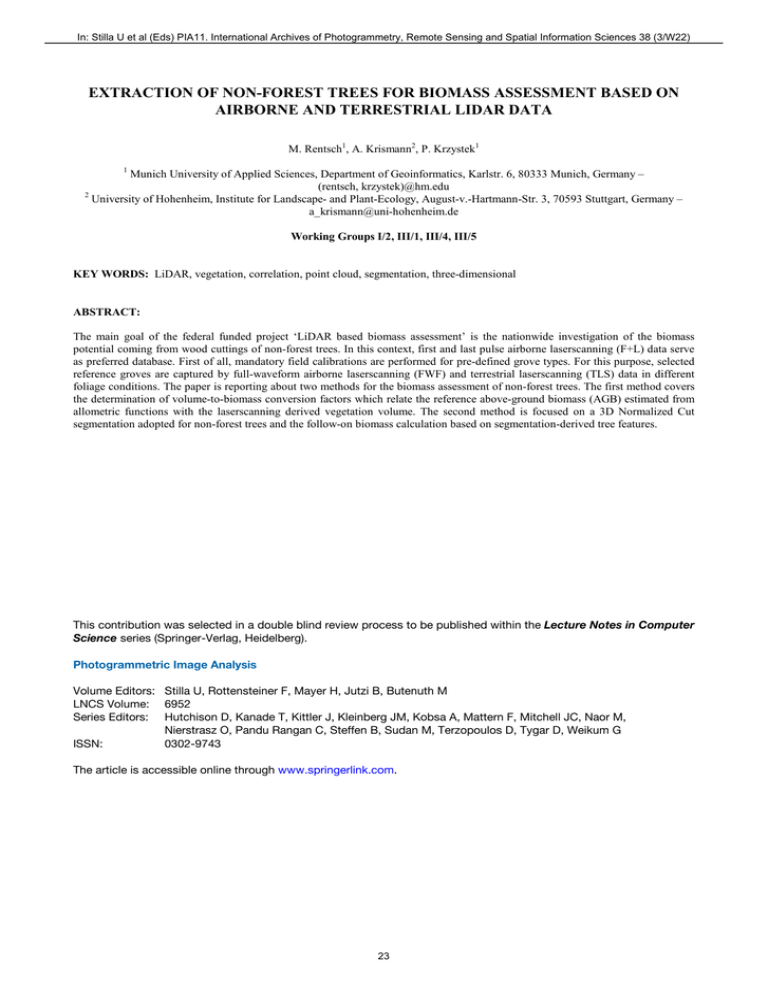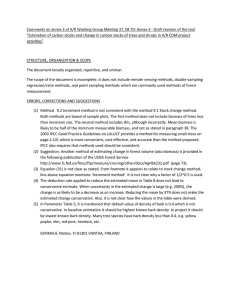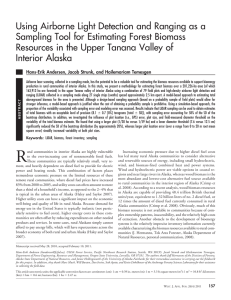Document 11841228
advertisement

In: Stilla U et al (Eds) PIA11. International Archives of Photogrammetry, Remote Sensing and Spatial Information Sciences 38 (3/W22) EXTRACTION OF NON-FOREST TREES FOR BIOMASS ASSESSMENT BASED ON AIRBORNE AND TERRESTRIAL LIDAR DATA M. Rentsch1, A. Krismann2, P. Krzystek1 1 Munich University of Applied Sciences, Department of Geoinformatics, Karlstr. 6, 80333 Munich, Germany – (rentsch, krzystek)@hm.edu 2 University of Hohenheim, Institute for Landscape- and Plant-Ecology, August-v.-Hartmann-Str. 3, 70593 Stuttgart, Germany – a_krismann@uni-hohenheim.de Working Groups I/2, III/1, III/4, III/5 KEY WORDS: LiDAR, vegetation, correlation, point cloud, segmentation, three-dimensional ABSTRACT: The main goal of the federal funded project ‘LiDAR based biomass assessment’ is the nationwide investigation of the biomass potential coming from wood cuttings of non-forest trees. In this context, first and last pulse airborne laserscanning (F+L) data serve as preferred database. First of all, mandatory field calibrations are performed for pre-defined grove types. For this purpose, selected reference groves are captured by full-waveform airborne laserscanning (FWF) and terrestrial laserscanning (TLS) data in different foliage conditions. The paper is reporting about two methods for the biomass assessment of non-forest trees. The first method covers the determination of volume-to-biomass conversion factors which relate the reference above-ground biomass (AGB) estimated from allometric functions with the laserscanning derived vegetation volume. The second method is focused on a 3D Normalized Cut segmentation adopted for non-forest trees and the follow-on biomass calculation based on segmentation-derived tree features. This contribution was selected in a double blind review process to be published within the Lecture Notes in Computer Science series (Springer-Verlag, Heidelberg). Photogrammetric Image Analysis Volume Editors: Stilla U, Rottensteiner F, Mayer H, Jutzi B, Butenuth M LNCS Volume: 6952 Series Editors: Hutchison D, Kanade T, Kittler J, Kleinberg JM, Kobsa A, Mattern F, Mitchell JC, Naor M, Nierstrasz O, Pandu Rangan C, Steffen B, Sudan M, Terzopoulos D, Tygar D, Weikum G ISSN: 0302-9743 The article is accessible online through www.springerlink.com. 23







